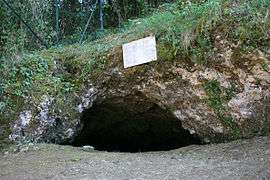La Chapelle-aux-Saints
| La Chapelle-aux-Saints | ||
|---|---|---|
| Commune | ||
 La Bouffia Bonneval, the discovery site of the Neanderthal burials of La Chapelle-aux-Saints | ||
| ||
 La Chapelle-aux-Saints Location within Nouvelle-Aquitaine region  La Chapelle-aux-Saints | ||
| Coordinates: 44°59′17″N 1°43′34″E / 44.9881°N 1.7261°ECoordinates: 44°59′17″N 1°43′34″E / 44.9881°N 1.7261°E | ||
| Country | France | |
| Region | Nouvelle-Aquitaine | |
| Department | Corrèze | |
| Arrondissement | Brive-la-Gaillarde | |
| Canton | Midi Corrézien | |
| Intercommunality | Sud Corrézien | |
| Government | ||
| • Mayor (2008–2014) | Georges Chastanet | |
| Area1 | 4.72 km2 (1.82 sq mi) | |
| Population (2009)2 | 216 | |
| • Density | 46/km2 (120/sq mi) | |
| Time zone | UTC+1 (CET) | |
| • Summer (DST) | UTC+2 (CEST) | |
| INSEE/Postal code | 19044 /19120 | |
| Elevation | 120–191 m (394–627 ft) | |
|
1 French Land Register data, which excludes lakes, ponds, glaciers > 1 km2 (0.386 sq mi or 247 acres) and river estuaries. 2 Population without double counting: residents of multiple communes (e.g., students and military personnel) only counted once. | ||
La Chapelle-aux-Saints is a commune in the Corrèze department in central France.
History
Neanderthal skeleton
The La Chapelle-aux-Saints cave, bordering the Sourdoire valley, revealed many archeological artifacts belonging to the late Mousterian techno-complex,[1] including the first ever recognized Neanderthal burial discovered on August 3, 1908.[2] Jean and Amédée Bouyssonie, as well as L. Bardon, led archaeological digs in the cave from 1905 to 1908, discovering over 1,000 pieces of stone industry (mainly flint), bones of different fauna including reindeer, bovid, horse, fox, wolf and even a rhinoceros’ tooth.[1] The most spectacular discovery was that of a very well preserved skeleton of an adult Neanderthal man who appears to have been intentionally buried in a rectangular pit 30 centimetres (12 in) deep, 1.45 metres (4.8 ft) long and 1 metre (3.3 ft) wide.[3]
This discovery led to a controversy for the existence of burials during the Mousterian. Arguments for the existence of a tomb were the sleeping position of the body, and the funeral "gifts" associated with the pit like stone tools and animal bones. Some archaeologists believe the Chapelle-aux-Saints cave wasn’t used as a habitat, but a place for funeral feasts.[1]
Modern period
During the French Revolution, the commune changed its name to La Chapelle-aux-Prés following a decree from the National Convention.
Population
| Historical population | ||
|---|---|---|
| Year | Pop. | ±% |
| 1962 | 206 | — |
| 1968 | 221 | +7.3% |
| 1975 | 217 | −1.8% |
| 1982 | 206 | −5.1% |
| 1990 | 179 | −13.1% |
| 1999 | 164 | −8.4% |
| 2008 | 206 | +25.6% |
See also
References
| Wikimedia Commons has media related to La Chapelle-aux-Saints. |
.svg.png)